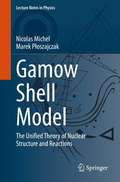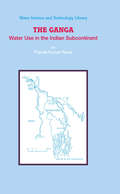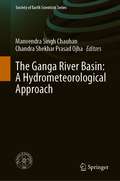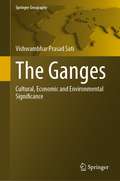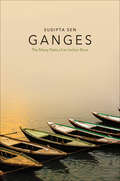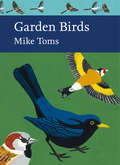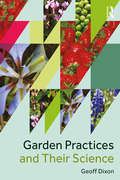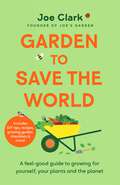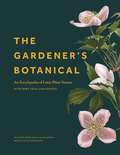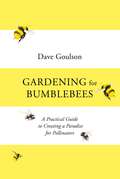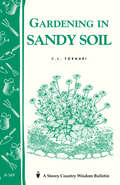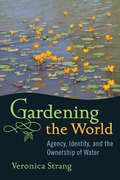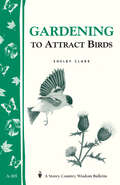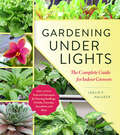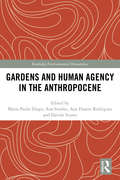- Table View
- List View
Gaming and Geography: A Multi-perspective Approach to Understanding the Impacts on Geography (Education) (Key Challenges in Geography)
by Michael Morawski Sebastian Wolff-SeidelThis book explores the uncharted territory where gaming and geography intersect in "Gaming and Geography (Education)." This book bridges the gap between video games and geography, delving into the constructivist creative processes of game development, gameplay, and critical reflections on video games' role in geographical discourses. Through a multi-perspective lens, the book examines how video games can facilitate the exploration of geographic questions and act as catalysts for critical discourses. Scholars shed light on the geographies presented in video games, including their representations, spatial images, and policies. By viewing video games as cultural and critical geography practices, the authors enrich the political, socio-cultural, and critical geographies associated with this medium. A key argument of the book is that video games can foster systemic competence and networked thinking, particularly in addressing complex socio-ecological challenges like climate change and migration. In contrast to traditional geography classes, digital games provide valuable simulations of complex systems, enhancing students' understanding and skills. The book also explores other possibilities such as digital field trips and language support to enhance the educational experience. "Gaming and Geography (Education)" offers a compelling narrative that highlights the diverse roles video games can play in geographic education. By exploring the intersection of gaming and geography, this book deepens our understanding of this dynamic relationship and its impact on critical geographies within the realm of video games.
Gamow Shell Model: The Unified Theory of Nuclear Structure and Reactions (Lecture Notes in Physics #983)
by Nicolas Michel Marek PłoszajczakThis book provides the first graduate-level, self-contained introduction to recent developments that lead to the formulation of the configuration-interaction approach for open quantum systems, the Gamow shell model, which provides a unitary description of quantum many-body system in different regimes of binding, and enables the unification in the description of nuclear structure and reactions. The Gamow shell model extends and generalizes the phenomenologically successful nuclear shell model to the domain of weakly-bound near-threshold states and resonances, offering a systematic tool to understand and categorize data on nuclear spectra, moments, collective excitations, particle and electromagnetic decays, clustering, elastic and inelastic scattering cross sections, and radiative capture cross sections of interest to astrophysics. The approach is of interest beyond nuclear physics and based on general properties of quasi-stationary solutions of the Schrödinger equation – so-called Gamow states. For the benefit of graduate students and newcomers to the field, the quantum-mechanical fundamentals are introduced in some detail. The text also provides a historical overview of how the field has evolved from the early days of the nuclear shell model to recent experimental developments, in both nuclear physics and related fields, supporting the unified description. The text contains many worked examples and several numerical codes are introduced to allow the reader to test different aspects of the continuum shell model discussed in the book.
The Ganga: Water Use in the Indian Subcontinent (Water Science and Technology Library #64)
by Pranab Kumar ParuaFrom time immemorial the Bengal Delta had been an important maritime des- nation for traders from all parts of the world. The actual location of the port of call varied from time to time in line with the natural hydrographic changes. From the early decades of the second millennium AD, traders from the European con- nent also joined the traders from the Arab countries, who had been the Forerunners in maritime trading with India. Daring traders and fortune seekers from Denmark, Holland, Belgium and England arrived at different ports of call along the Hooghly river. The river had been, in the meantime, losing its pre-eminence as the main outlet channel of the sacred Ganga into the Bay of Bengal, owing to a shift of ?ow towards east near Rajmahal into the Padma, which had been so long, carried very small part of the large volume of ?ow. On a cloudy afternoon on August 24, 1690 the British seafarer Job Charnock rested his oars at Kolkata and started a new chapter in the life of a sleepy village, bordering the Sunderbans which was ‘a tangled region of estuaries, rivers and water courses, enclosing a vast number of islands of various shapes and sizes. ’ and infested with a large variety of wild animals. In the language of the British Nobel Laureate (1907) Rudyard Kipling (1865–1936). ???? ???? Thus the midday halt of Charnock grew a city.
The Ganga River Basin: A Hydrometeorological Approach (Society of Earth Scientists Series)
by Manvendra Singh Chauhan Chandra Shekhar Prasad OjhaThis book presents an overview of the hydrometeorological and hydrological studies and assists in tackling challenges posed by climate and land use land cover changes. The Ganga River is one of the major living streams on the planet earth and very important river system in India. This holy river is a lifeline for approximately five hundred million people. In the last few decades, River Ganges has been subjected to tremendous pressures with respect to both water quantity and water quality. This situation, already one of the alarming magnitudes, has been further provoked by hydrometeorological changes resulting in droughts, floods and reduced groundwater levels and river flows in addition to the poor river health. Thus, it is imperative to assess the various complexities and possible solutions for better management of River Ganges. This book is a valuable addition to the literature and contributes to research on River Ganges which will help better planning and management of Ganga river basin. The hydrological and hydrometeorological aspects covered in this book help practitioners, researchers, policymakers and other stakeholders.
The Ganges: Cultural, Economic and Environmental Significance (Springer Geography)
by Vishwambhar Prasad Sati‘The Ganges: Cultural, Economic, and Environmental Importance’ is a geographical, cultural, economic, and environmental interpretation of the Ganga River. The Ganga River originates from Gaumukh- situated in the high Himalaya, flows through the world’s biggest fertile alluvial plain, and inlets into the Bay of Bengal at Ganga Sagar. It makes a unique natural and cultural landscape and is believed to be the holiest river of India. The Hindus called it ‘Mother Ganga’ and worship it. The towns/cities, situated on its bank, are world-famous and are known as the highland and valley pilgrimages. The water of the Ganga is pious, and the Hindus use it on different occasions while performing the rituals and customs. This book is unique because no previous study which presents a complete and comprehensive geographical description of the Ganga has been composed. This book presents the historical and cultural significance of the Ganga and its tributaries. Empirical, archival, and observation methods were applied to conduct this study. There are a total of 10 chapters in this book such as ‘Introduction’, ‘the Ganga Basin’, ‘Geography of the Ganga Basin’, ‘the Ganges System: Ganga and its Tributaries’, ‘Ganga between Gaumukh and Uttarkashi’, ‘the Major Cultural Towns’, ‘Major Fairs and Festivals’, ‘Economic Significance of the Ganga’, ‘Environmental Issues’, and ‘Conclusions’. The contents of the book are enriched by 89 figures, 15 tables, and substantial citations and references.
Ganges: The Many Pasts of an Indian River
by Sudipta SenA sweeping, interdisciplinary history of the world’s third-largest river, a potent symbol across South Asia and the Hindu diaspora Originating in the Himalayas and flowing into the Bay of Bengal, the Ganges is India’s most important and sacred river. In this unprecedented work, historian Sudipta Sen tells the story of the Ganges, from the communities that arose on its banks to the merchants that navigated its waters, and the way it came to occupy center stage in the history and culture of the subcontinent. Sen begins his chronicle in prehistoric India, tracing the river’s first settlers, its myths of origin in the Hindu tradition, and its significance during the ascendancy of popular Buddhism. In the following centuries, Indian empires, Central Asian regimes, European merchants, the British Empire, and the Indian nation-state all shaped the identity and ecology of the river. Weaving together geography, environmental politics, and religious history, Sen offers in this lavishly illustrated volume a remarkable portrait of one of the world’s largest and most densely populated river basins.
The Ganges Water Diversion: Environmental Effects and Implications (Water Science and Technology Library #49)
by M. Monirul Qader MirzaThis book deals with environmental effects on both sides of the border between Bangladesh and India caused by the Ganges water diversion. This issue came to my attention in early 1976 when news media in Bangladesh and overseas, began publications of articles on the unilateral withdrawal of a huge quantity of water from the Ganges River through the commissioning of the Farakka Barrage in India. I first pursued the subject professionally in 1984 while working as a contributor for Bangladesh Today, Holiday and New Nation. During the next two decades, I followed the protracted hydro-political negotiations between the riparian countries in the Ganges basin, and I traveled extensively to observe the environmental and ecological changes in Bangladesh as well as India that occurred due to the water diversion. The Ganges, one of the longest rivers of the world originates at the Gangotri glacier in the Himalayas and flows across the plains of North India. Eventually the river splits into two main branches and empties into the Bay of Bengal. The conflict of diversion and sharing of the Ganges water arose in the middle of the last century when the government of India decided to implement a barrage at Farakka to resolve a navigation problem at the Kolkata Port.
The GANNI Playbook: How to Get Started Creating a Responsible Business
by Nicolaj Reffstrup Brooke Roberts-Islam'It’s Ganni’s journey from cult Scandi favourite to a leader in the sustainability space'Emily Chan, VogueThis book is about what happened when a business leader decided not to bury his head in the sand about climate change; when he found the conversation with his kids about floods from melting ice caps too painful. This book asks what it means to force yourself to take a different business path, where the destination is a responsible and profit-making business.In The GANNI Playbook, Nicolaj Reffstrup unveils the strategies that propelled GANNI to international stardom, while candidly unravelling the cultural, operational and creative components required to construct a business that embraces an uncertain future.'GANNI offers a blueprint for how to embed sustainability from within'Rachel Cernansky, Vogue Business'What's the secret to sustainable success? There is no secret. GANNI is willing to share. In fact, it’s doing exactly that'Rose Dodd, Sleek
Ganoderma Diseases of Tropical Crops
by Dr Carmel A Pilotti Paul BridgeThe fungal genus Ganoderma includes around 80 currently recognized species that are widely distributed in temperate, subtropical and tropical regions, and cause disease in a range of economically important perennial crops and tree-like plants. Ganoderma root and lower stem rots have a significant impact on yields from crops including oil palm, coconut, beverage crops, Acacia and rubber. The identification of species responsible for stem and butt rots is often ambiguous as closely related species may only be distinguished by subtle morphological differences. Within species there can be considerable morphological plasticity and this can make morphology-based identification difficult, particularly for species described from a single specimen. Molecular techniques are helping to slowly resolve Ganoderma taxonomy but it will be some time (if ever) before the taxonomy is fully resolved. This book brings together information on Ganoderma species that are reported to be responsible for crop diseases in tropical and sub-tropical agriculture and covers taxonomy, biology, genetics, aetiology, epidemiology and control. This book is an essential resource for researchers in Ganoderma in crop science and tropical agriculture, as well as practitioners and industry.
Garbage Land: On the Secret Trail of Trash
by Elizabeth RoyteOut of sight, out of mind ... Into our trash cans go dead batteries, dirty diapers, bygone burritos, broken toys, tattered socks, eight-track cassettes, scratched CDs, banana peels.... But where do these things go next? In a country that consumes and then casts off more and more, what actually happens to the things we throw away? In Garbage Land, acclaimed science writer Elizabeth Royte leads us on the wild adventure that begins once our trash hits the bottom of the can. Along the way, we meet an odor chemist who explains why trash smells so bad; garbage fairies and recycling gurus; neighbors of massive waste dumps; CEOs making fortunes by encouraging waste or encouraging recycling-often both at the same time; scientists trying to revive our most polluted places; fertilizer fanatics and adventurers who kayak amid sewage; paper people, steel people, aluminum people, plastic people, and even a guy who swears by recycling human waste. With a wink and a nod and a tightly clasped nose, Royte takes us on a bizarre cultural tour through slime, stench, and heat-in other words, through the back end of our ever-more supersized lifestyles. By showing us what happens to the things we've "disposed of," Royte reminds us that our decisions about consumption and waste have a very real impact-and that unless we undertake radical change, the garbage we create will always be with us: in the air we breathe, the water we drink, and the food we consume. Radiantly written and boldly reported, Garbage Land is a brilliant exploration into the soiled heart of the American trash can.
Garden Birds (Collins New Naturalist Library #140)
by Mike TomsGardens make a significant contribution to the amount of urban green space and are the main contributors to urban biodiversity. Birds are one of the most visible components of this urban biodiversity, and many of us enjoy attracting wild birds into our gardens.
The Garden City Utopia: A Critical Biography of Ebenezer Howard
by Robert BeeversEbenezer Howard is recognised as a pioneer of town planning throughout the industrialised world; Britain's new towns, deriving from the garden cities he founded, are his monument. But Howard was more than a town planner. He was first and foremost a social reformer, and his garden city was intended to be merely the first step towards a new social and industrial order based on common ownership of land. This is the first comprehensive study of Howard's theories, which the author traces back to their origins in English puritan dissent and forward to Howard's attempt to build his new society in microcosm at Letchworth and Welwyn.
Garden Practices and Their Science
by Geoff DixonWritten in a clear and accessible style, Garden Practices and Their Science guides gardeners in the practical arts of plant husbandry and in their understanding of its underpinning principles. The author, Professor Geoff Dixon, is an acknowledged and internationally respected horticulturist and microbiologist; he intertwines these arts and principles carefully, expertly leading readers from one to the other. Achieving the manipulation of plant life is described in eight full-colour, well-illustrated chapters covering the growing of potatoes, bulb onions, legumes, small-seeded vegetables, soft fruit, bulbs and herbaceous ornamentals in great detail. Environmental factors controlling the successful husbandry of these crops is described in simple, non-technical language, increasing gardeners’ enjoyment and competence. Gardeners are also informed of the tools and equipment they require and their safe use. Also provided are a series of simple, straightforward tests identifying the aerial and soil environments beneficial for plant growth using readily accessible domestic tools. Discussions of very straightforward techniques for vegetative propagation conclude this book. Each chapter ends with a list of the gardening knowledge that has been gained by readers. The structure of this book fulfils a longstanding need for descriptions of practical skills integrated with the corresponding biological reactions of plants. Emphasis is placed on gardeners’ development of healthy soils, which encourage vigorous, active root systems capable of withstanding stresses—an aspect of gardening that rarely receives sufficient attention. Tailored for readers requiring clear and concise directions, this very practical book is an instruction manual directed at early-stage gardening learners. These include people of all ages and requirements such as new garden owners, allotment-holders, apprentices and students of basic levels in the Royal Horticultural Society’s or City & Guilds qualifications, career changers, community gardeners and those needing applied biological knowledge for GCSE examinations.
Garden Practices and Their Science
by Geoff DixonWritten in a clear and accessible style, Garden Practices and Their Science guides gardeners in the practical arts of plant husbandry and in their understanding of its underpinning principles. The author, Professor Geoff Dixon, is an acknowledged and internationally respected horticulturist and microbiologist; he intertwines these arts and principles carefully, expertly leading readers from one to the other. Achieving the manipulation of plant life is described in eight full-colour, well-illustrated chapters covering the growing of potatoes, bulb onions, legumes, small-seeded vegetables, soft fruit, bulbs and herbaceous ornamentals in great detail. Environmental factors controlling the successful husbandry of these crops is described in simple, non-technical language, increasing gardeners’ enjoyment and competence. Gardeners are also informed of the tools and equipment they require and their safe use. Also provided are a series of simple, straightforward tests identifying the aerial and soil environments beneficial for plant growth using readily accessible domestic tools. Discussions of very straightforward techniques for vegetative propagation conclude this book. Each chapter ends with a list of the gardening knowledge that has been gained by readers. The structure of this book fulfils a longstanding need for descriptions of practical skills integrated with the corresponding biological reactions of plants. Emphasis is placed on gardeners’ development of healthy soils, which encourage vigorous, active root systems capable of withstanding stresses—an aspect of gardening that rarely receives sufficient attention. Tailored for readers requiring clear and concise directions, this very practical book is an instruction manual directed at early-stage gardening learners. These include people of all ages and requirements such as new garden owners, allotment-holders, apprentices and students of basic levels in the Royal Horticultural Society’s or City & Guilds qualifications, career changers, community gardeners and those needing applied biological knowledge for GCSE examinations.
Garden Revolution: How Our Landscapes Can Be a Source of Environmental Change
by Larry Weaner Thomas ChristopherGarden Revolution shows how an ecological approach to planting can lead to beautiful gardens that buck much of conventional gardening&’s counter-productive, time-consuming practices.
Garden To Save The World: A Feel-Good Guide to Growing for Yourself, Your Plants and the Planet
by Joe ClarkNo matter your space, gardening expert and social media sensation Joe Clark will help you find joy and peace in the natural world.Nature enthusiast Joe Clark is here to help you make the most of the outdoors, whether or not you have a garden of your own. Garden to Save the World covers everything from growing your own food and eating seasonally to keeping vital ecosystems alive by encouraging wildlife and appreciating all nature has to offer.Garden to Save the World showcases just how fantastic the natural world is, both for your physical and mental health. It’s a fun, positive guide to the joys of the natural world as a haven for all. The book is complete with practical takeaways on how to make an urban bee hotel, zero waste tips, going wild, using your garden as a supermarket and more. There are fun facts and surprising stories about what your garden can do for you, your community and the planet. Perfect for any budding or seasoned nature lover.- DIY tips on how to make your garden more sustainable- Growing guides so you can grow your favourite vegetables- Advice on how to avoid food waste with tips on how to store, preserve and ferment food- Delicious recipes to try at home- Checklists throughout the book Joe has a brilliant community of nearly 2 million online, where he shares top tips on his Joesgarden platforms.
The Gardener's Botanical: An Encyclopedia of Latin Plant Names - with More than 5,000 Entries
by Ross BaytonThe definitive guide to botanical LatinUnlock the secrets of botanical Latin with this beautifully illustrated encyclopedia. The Gardener's Botanical contains definitions of more than 5,000 plant names—from abbreviatus ("shortened") to zonatus ("with bands")—along with more than 350 color illustrations.Scientific plant names are an invaluable tool for those who understand them. Formed from Greek and, more commonly, from Latin root words, not only do they make it possible for gardeners and botanists to communicate, they also contain a wealth of hidden information. The Gardener's Botanical is the key to unlocking these secrets. This guide contains a breathtaking array of botanical names in alphabetical order. Each word is listed with a pronunciation guide, definition, example plant, and, where appropriate, etymology. Also included in this illuminating guide are special features on important plant genera, fact boxes, essays focusing on the history and importance of Latin names and botanical illustrations, and an index of common names with more than 2,000 popular plants, cross-referenced with their binomial name in Latin.
The Gardener's Botanical: An Encyclopedia of Latin Plant Names - with More than 5,000 Entries
by Ross BaytonThe definitive guide to botanical LatinUnlock the secrets of botanical Latin with this beautifully illustrated encyclopedia. The Gardener's Botanical contains definitions of more than 5,000 plant names—from abbreviatus ("shortened") to zonatus ("with bands")—along with more than 350 color illustrations.Scientific plant names are an invaluable tool for those who understand them. Formed from Greek and, more commonly, from Latin root words, not only do they make it possible for gardeners and botanists to communicate, they also contain a wealth of hidden information. The Gardener's Botanical is the key to unlocking these secrets. This guide contains a breathtaking array of botanical names in alphabetical order. Each word is listed with a pronunciation guide, definition, example plant, and, where appropriate, etymology. Also included in this illuminating guide are special features on important plant genera, fact boxes, essays focusing on the history and importance of Latin names and botanical illustrations, and an index of common names with more than 2,000 popular plants, cross-referenced with their binomial name in Latin.
Gardening for Bumblebees: A Practical Guide to Creating a Paradise for Pollinators
by Dave GoulsonFrom the Sunday Times bestselling author of A Sting In The Tale comes this practical guide to creating a paradise for pollinators.There are twenty six different species of bumblebees to be found in the UK, of around 250 species worldwide. Bumblebees are among the most important of our insects; these superb pollinators ensure that wildflowers set seed and reappear each year, and that our vegetable and fruit crops give us bountiful harvests. With the decline in the populations of our wild bees, these beloved creatures need looking after more than ever. Gardening for Bumblebees shows you how you can provide a refuge for bumblebees to feed, breed and thrive. No matter how large or small your space is, Dave Goulson shows you how you can make a pollinator-friendly haven. In this book you will learn the best trees, shrubs and flowers for pollinators, how to create the perfect nest and breeding site, and the best ways to control pests. Gardening For Bumblebees will encourage and inspire gardeners and allotmenters alike to make their patch more bee friendly. Praise for Dave Goulson'Dave Goulson... has perfected the art of turning the entomologist's technical expertise into easy-reading everyman's prose'Mark Cocker, Spectator'Goulson reminds himself that he 'began studying bumblebees not because they are important pollinators but because they are fascinating, because they behave in interesting and mysterious ways, and because they are rather loveable' Hannah Rosefield, Literary Review
Gardening in Sandy Soil: Storey's Country Wisdom Bulletin A-169 (Storey Country Wisdom Bulletin)
by C. L. FornariSince 1973, Storey's Country Wisdom Bulletins have offered practical, hands-on instructions designed to help readers master dozens of country living skills quickly and easily. There are now more than 170 titles in this series, and their remarkable popularity reflects the common desire of country and city dwellers alike to cultivate personal independence in everyday life.
Gardening the World: Agency, Identity and the Ownership of Water
by Veronica StrangAround the world, intensifying development and human demands for fresh water are placing unsustainable pressures on finite resources. Countries are waging war over transboundary rivers, and rural and urban communities are increasingly divided as irrigation demands compete with domestic desires. Marginal groups are losing access to water as powerful elites protect their own interests, and entire ecosystems are being severely degraded. These problems are particularly evident in Australia, with its industrialised economy and arid climate. Yet there have been relatively few attempts to examine the social and cultural complexities that underlie people's engagements with water. Based on long-term ethnographic fieldwork in two major Australian river catchments (the Mitchell River in Cape York, and the Brisbane River in southeast Queensland), this book examines their major water using and managing groups: indigenous communities, farmers, industries, recreational and domestic water users, and environmental organisations. It explores the issues that shape their different beliefs, values and practices in relation to water, and considers the specifically cultural or sub-cultural meanings that they encode in their material surroundings. Through an analysis of each group's diverse efforts to 'garden the world', it provides insights into the complexities of human-environmental relationships.
Gardening to Attract Birds: Storey's Country Wisdom Bulletin A-205 (Storey Country Wisdom Bulletin)
by Shelby ClarkSince 1973, Storey's Country Wisdom Bulletins have offered practical, hands-on instructions designed to help readers master dozens of country living skills quickly and easily. There are now more than 170 titles in this series, and their remarkable popularity reflects the common desire of country and city dwellers alike to cultivate personal independence in everyday life.
Gardening Under Lights: The Complete Guide for Indoor Growers
by Leslie F. HalleckA complete, practical manual for growing plants indoors.
Gardens and Human Agency in the Anthropocene (Routledge Environmental Humanities)
by Maria Paula Diogo Ana Simões Ana Duarte Rodrigues Davide ScarsoThis volume discusses gardens as designed landscapes of mediation between nature and culture, embodying different levels of human control over wilderness, defining specific rules for this confrontation and staging different forms of human dominance. The contributing authors focus on ways of rethinking the garden and its role in contemporary society, using it as a crossover platform between nature, science and technology. Drawing upon their diverse fields of research, including History of Science and Technology, Environmental Studies, Gardens and Landscape Studies, Urban Studies, and Visual and Artistic Studies, the authors unveil various entanglements woven in the past between nature and culture, and probe the potential of alternative epistemologies to escape the predicament of fatalistic dystopias that often revolve around the Anthropocene debate. This book will be of great interest to those studying environmental and landscape history, the history of science and technology, historical geography, and the environmental humanities.
Gardens and Human Agency in the Anthropocene (Routledge Environmental Humanities)
This volume discusses gardens as designed landscapes of mediation between nature and culture, embodying different levels of human control over wilderness, defining specific rules for this confrontation and staging different forms of human dominance. The contributing authors focus on ways of rethinking the garden and its role in contemporary society, using it as a crossover platform between nature, science and technology. Drawing upon their diverse fields of research, including History of Science and Technology, Environmental Studies, Gardens and Landscape Studies, Urban Studies, and Visual and Artistic Studies, the authors unveil various entanglements woven in the past between nature and culture, and probe the potential of alternative epistemologies to escape the predicament of fatalistic dystopias that often revolve around the Anthropocene debate. This book will be of great interest to those studying environmental and landscape history, the history of science and technology, historical geography, and the environmental humanities.

